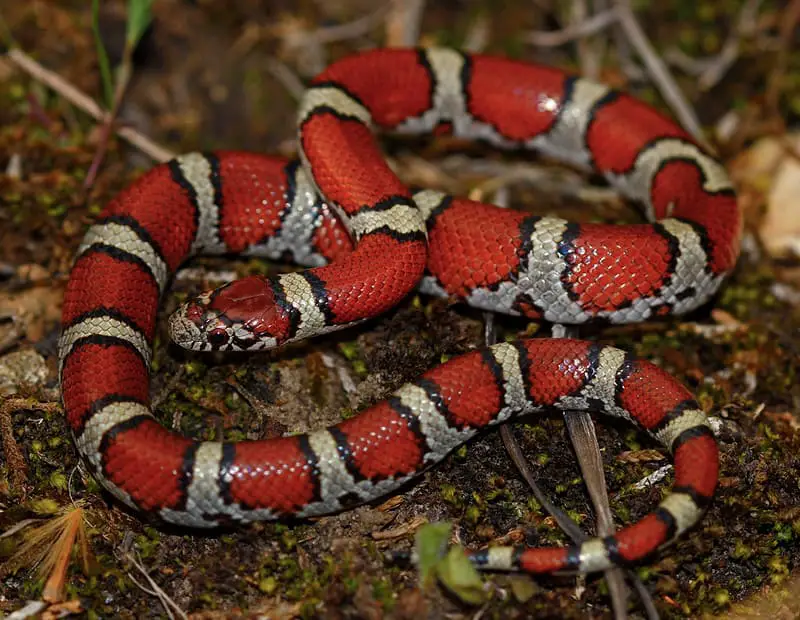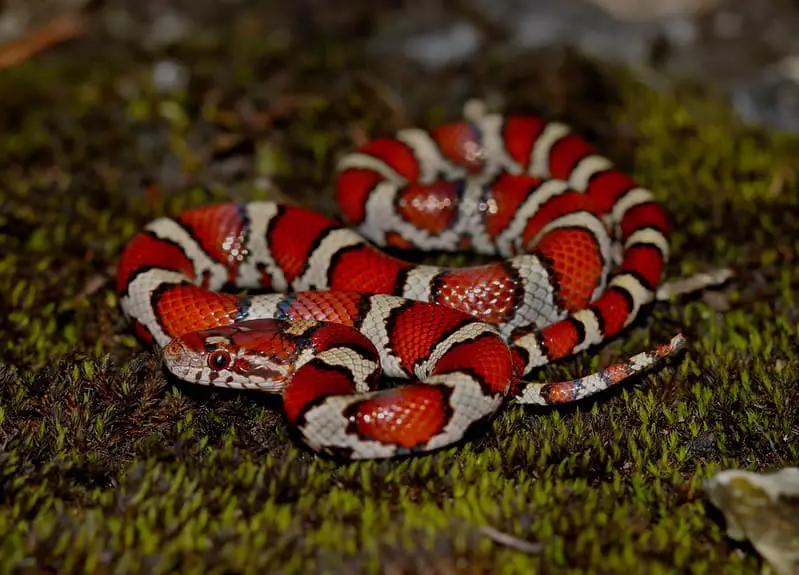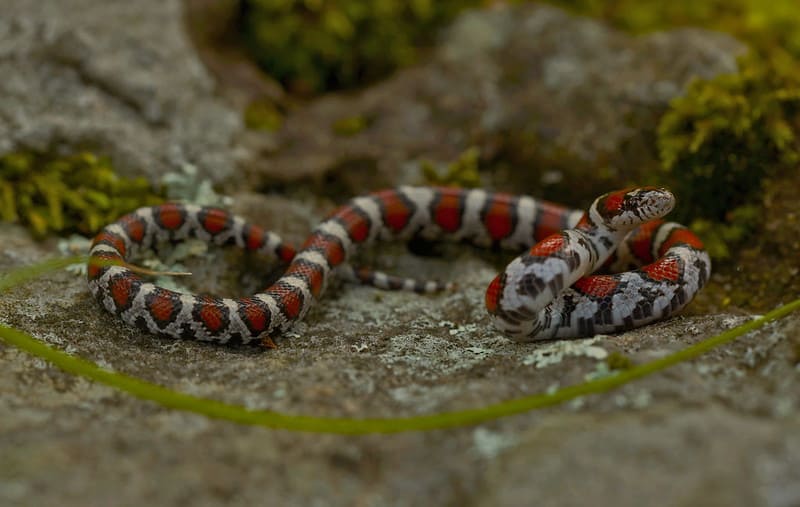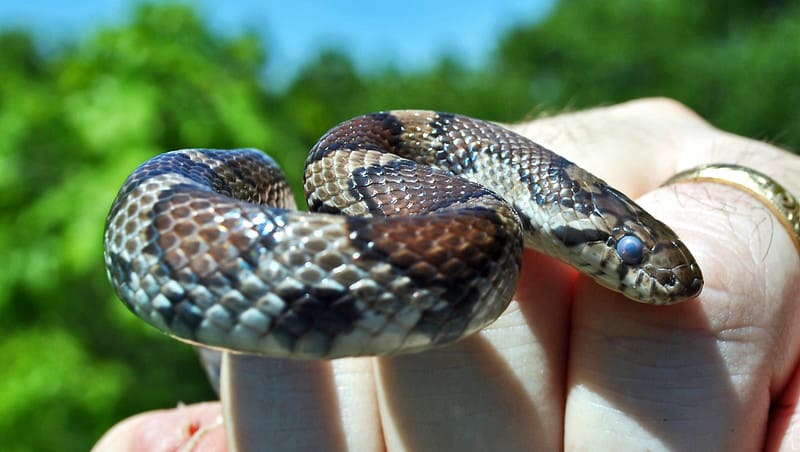Milk snakes are a fascinating group of non-venomous snakes found throughout the Americas. Renowned for their striking colors and distinctive patterns, milk snakes are a popular choice among reptile enthusiasts. To truly understand and appreciate these beautiful creatures, it’s essential to explore their natural habitat, behaviors, and ecological significance. In this comprehensive guide, we will delve into the world of milk snakes and gain insights into their habitat, range, and lifestyle.

Introduction to Milk Snakes
Milk snakes belong to the genus Lampropeltis, which includes a diverse group of colubrid snakes found in North and Central America. These snakes are known for their vibrant and often mimicry-based coloration, which is believed to serve as a defense mechanism to deter predators.
Species and Subspecies
The Lampropeltis genus includes various species and subspecies of milk snakes. Some well-known subspecies include the Eastern Milk Snake (Lampropeltis t. triangulum), the Red Milk Snake (Lampropeltis t. syspila), and the Honduran Milk Snake (Lampropeltis t. hondurensis). Each subspecies exhibits its own unique coloration and pattern variations.
Geographic Distribution
Milk snakes have a widespread distribution, ranging from the eastern United States to Central America. They inhabit a variety of ecosystems, from woodlands to grasslands and even urban areas.
The Natural Habitat of Milk Snakes
Milk snakes are adaptable and can thrive in diverse environments. Understanding their natural habitat is key to appreciating their unique adaptations and behaviors. Let’s explore the primary features of their habitat:
1. Geographic Range
Milk snakes are found throughout North, Central, and even parts of South America. Their range extends from southeastern Canada in North America to Venezuela and Colombia in South America. The specific species and subspecies of milk snakes vary in their geographic distribution.
2. Terrestrial Habitats
Milk snakes are primarily terrestrial snakes, meaning they live and move on the ground. They can be found in a wide range of terrestrial habitats, including:
- Deciduous Forests: These snakes often inhabit deciduous woodlands, where they can be found under leaf litter, fallen logs, and rocks. They are excellent at navigating through the forest floor.
- Grasslands and Prairies: Some milk snake species, such as the Eastern Milk Snake, are well-adapted to grasslands and prairies. They are skilled at hunting for small rodents and reptiles in open areas.
- Urban and Suburban Areas: In some regions, milk snakes have adapted to human-altered environments, including urban and suburban areas. They can be found in gardens, parks, and abandoned buildings.
- Desert Scrub: In parts of their range, such as the southwestern United States and northern Mexico, milk snakes are found in desert scrub environments. These arid landscapes offer them hiding spots in rock crevices and burrows.
3. Microhabitat Selection
Milk snakes are known for their excellent microhabitat selection. They often seek refuge in areas that provide cover and protection from predators. Common microhabitats include:
- Leaf Litter: Among leaf litter, milk snakes can remain concealed and find small prey items, such as insects and arachnids.
- Rock Piles and Crevices: Rocky areas offer milk snakes a safe retreat from predators and environmental extremes. They may also find food, such as rodents, in these rocky environments.
- Burrows: Milk snakes occasionally use burrows created by other animals as hiding spots. These burrows protect them from temperature fluctuations and predators.
- Underground: Some milk snakes are skilled burrowers and may dig their own shallow burrows in loose soil.
4. Climbing Ability
While primarily terrestrial, some milk snakes display climbing behavior. They can ascend trees and shrubs in search of prey or to escape predators. Their climbing ability is especially pronounced in the arboreal subspecies, such as the Green Milk Snake (Lampropeltis t. hondurensis).

Diet and Feeding Habits
Understanding the natural diet and feeding habits of milk snakes sheds light on their role in their respective ecosystems. These snakes are opportunistic predators, which means they feed on a variety of prey items:
1. Small Mammals
Milk snakes are known to consume a range of small mammals, including:
- Mice: Mice are a primary food source for many milk snakes. They use constriction to subdue and consume these rodents.
- Shrews: Smaller mammals like shrews are also part of their diet. Milk snakes are efficient hunters, often locating shrews in leaf litter or underground burrows.
- Voles: Voles are another common prey item for milk snakes. Their burrowing behavior can make them accessible to these snakes.
2. Reptiles
Milk snakes are opportunistic predators of reptiles, and their diet may include:
- Other Snakes: Some milk snake subspecies feed on other snakes, such as smaller colubrids and even venomous snakes. This behavior is observed in snakes like the Scarlet Kingsnake (Lampropeltis elapsoides), which mimics the venomous Coral Snake (Micrurus fulvius).
- Lizards: Certain milk snake species and subspecies include lizards in their diet, particularly in regions with diverse reptile populations.
- Eggs: Milk snakes are known to consume reptile eggs, including those of ground-nesting turtles and lizards.
3. Amphibians
Amphibians, such as frogs and salamanders, can be part of the diet of milk snakes, especially during the breeding season when these prey items are more abundant in wetland habitats.
4. Invertebrates
Invertebrates, including insects and arachnids, can make up a portion of the milk snake’s diet. They are skilled at foraging for these small prey items among leaf litter and in other terrestrial microhabitats.
5. Bird Eggs
In some instances, milk snakes may consume bird eggs, particularly those of ground-nesting birds. Their adaptability allows them to exploit various food sources.

Reproductive Behavior and Habitat Use
Milk snakes exhibit distinct reproductive behaviors and habitat use patterns. These behaviors are influenced by factors such as climate, availability of prey, and habitat characteristics:
1. Breeding Season
The breeding season for milk snakes varies depending on their geographic location. In the northern parts of their range, where winters are cold and food availability is seasonal, the breeding season typically occurs in the spring, following hibernation.
In more temperate regions, where food is available year-round, breeding can take place at different times. Female milk snakes release pheromones to attract males, initiating courtship and copulation.
2. Egg Laying
After mating, female milk snakes lay eggs rather than giving birth to live young. The number of eggs can vary but generally ranges from 2 to 17 eggs, depending on the species and the female’s size and health. These eggs are typically deposited in concealed locations, such as rotting logs, leaf litter, or burrows.
3. Incubation and Nesting Sites
Milk snakes do not provide parental care for their eggs. Instead, the eggs are left to develop in the nest site. The ambient temperature plays a significant role in incubation, and it can take several weeks for the eggs to hatch.
Nesting sites are selected based on their ability to provide stable and suitable conditions for incubation. These sites are often chosen to protect the eggs from environmental extremes and predators.
4. Hatchling Behavior
Once the eggs hatch, milk snake hatchlings are left to fend for themselves. They must quickly develop the skills necessary for finding food and avoiding predators. Hatchlings often have a vivid and contrasting coloration that may differ from the pattern and coloration of adults.
Ecological Significance
Milk snakes play a vital role in their ecosystems, as they are integral components of local food webs. Their ecological significance includes:
1. Controlling Small Mammal Populations
By feeding on small mammals like mice, voles, and shrews, milk snakes help control rodent populations. This can have a positive impact on the balance of local ecosystems and reduce potential damage caused by overpopulated rodent species.
2. Preying on Venomous Snakes
Some milk snake subspecies, like the Scarlet Kingsnake, are known for their mimicry of venomous snakes, such as Coral Snakes. By preying on actual venomous snakes, they contribute to regulating their populations and potentially protect humans from dangerous encounters with venomous species.
3. Serving as Prey
Milk snakes themselves serve as a food source for various predators, including birds of prey, larger snakes, and certain mammals. This makes them an integral part of the food chain in their habitats.
4. Biodiversity
Milk snakes are part of the rich biodiversity of their ecosystems. Their presence contributes to the overall health and diversity of these environments.

Conservation Status
The conservation status of milk snakes varies depending on the species and geographic location. Many milk snake species and subspecies are not considered threatened or endangered. However, some populations are at risk due to habitat destruction, illegal collection for the pet trade, and road mortality.
Conservation efforts are essential to ensure the preservation of these snakes and their habitats. This includes habitat protection, responsible pet trade practices, and research to better understand their ecological roles and habitat requirements.
Challenges to Milk Snake Habitat
Milk snakes face several challenges to their habitat, many of which are anthropogenic (human-caused) in nature:
1. Habitat Destruction
Deforestation, urbanization, and agricultural expansion continue to impact the natural habitats of milk snakes. As their terrestrial environments are altered or destroyed, their populations can suffer.
2. Road Mortality
Roads can pose a significant threat to milk snakes. Snakes are often killed or injured when they attempt to cross roads, as they are difficult for drivers to spot, especially at night.
3. Illegal Collection
Milk snakes are sometimes collected from the wild for the exotic pet trade. Unregulated and unsustainable collection can have detrimental effects on local populations.
4. Climate Change
Climate change can alter the temperature and humidity patterns in the habitats of milk snakes, potentially impacting their ability to thermoregulate and find food.
Conservation and Responsible Ownership
Milk snakes are a valuable part of our natural ecosystems, and their conservation should be a priority. Responsible ownership and ethical practices can help protect these snakes in the wild:
1. Support Conservation Efforts
Consider supporting organizations and initiatives dedicated to the conservation of reptiles and their habitats. These efforts can contribute to the protection of milk snake populations.
2. Choose Captive-Bred Snakes
If you’re interested in owning a milk snake as a pet, choose one that is captive-bred rather than wild-caught. Captive breeding helps reduce pressure on wild populations.
3. Promote Habitat Conservation
Advocate for the preservation of natural habitats and ecosystems where milk snakes are found. Participate in local conservation efforts and raise awareness about the importance of these environments.
4. Responsible Pet Ownership
If you decide to keep a milk snake as a pet, prioritize responsible pet ownership. Ensure that you provide proper care, nutrition, and a safe and enriched environment for your snake.
Conclusion
Milk snakes are captivating creatures with diverse habitats and behaviors. Their adaptability allows them to thrive in a variety of terrestrial environments, from woodlands to grasslands and even urban areas. As opportunistic predators, they play crucial roles in their ecosystems by controlling small mammal populations, preying on venomous snakes, and contributing to biodiversity.
Conservation of milk snakes and their habitats is essential to maintain their place in the natural world. Supporting conservation efforts, choosing captive-bred snakes, and practicing responsible pet ownership are ways in which individuals can contribute to the preservation of these remarkable reptiles. Understanding the natural habitat and ecological significance of milk snakes deepens our appreciation for these beautiful and often misunderstood snakes.
